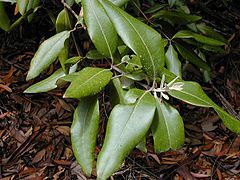Syncarpia
| Syncarpia subsp. var. | ||||||||||||||||||||||||||||||||||||||||||||||||||||||||
|---|---|---|---|---|---|---|---|---|---|---|---|---|---|---|---|---|---|---|---|---|---|---|---|---|---|---|---|---|---|---|---|---|---|---|---|---|---|---|---|---|---|---|---|---|---|---|---|---|---|---|---|---|---|---|---|---|

|
|
| ||||||||||||||||||||||||||||||||||||||||||||||||||||||
| ||||||||||||||||||||||||||||||||||||||||||||||||||||||||
Syncarpia is a small genus of trees in the myrtle family (Myrtaceae). They are native to Queensland and New South Wales in Australia. They are unusual among the Myrtaceae in that the leaves are opposite rather than alternate as is the norm for the family.
The species are commonly known as turpentine trees due to the odour of their resin.
| Standard Cyclopedia of Horticulture |
|---|
|
Syncarpia (Greek, together and fruit, referring to the head-like clusters of caps.). Myrtaceae. Trees, one of which is intro. into Calif.: lvs. opposite, ovate, evergreen: fls. gathered in globose heads: peduncles 1-headed, lateral axillary or paniculate at the ends of the branches, rather small, white; calyx-tube adnate at base of ovary, turbinate or campanulate, segms. 4, rarely 5, persistent; petals 4, rarely 5; stamens many, free; ovary inferior, 2-3-celled: caps. adnate to the calyx and inclosed in it.—Two species, Austral. CH
|
Cultivation
Propagation
Pests and diseases
Species
They include:
S. glomulifera is considered a weed in Hawaii.
Gallery
References
External links
- w:Syncarpia. Some of the material on this page may be from Wikipedia, under the Creative Commons license.
- Syncarpia QR Code (Size 50, 100, 200, 500)
